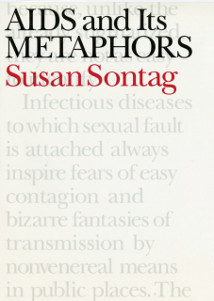
A disease is a particular abnormal condition that adversely affects the structure or function of all or part of an organism and is not immediately due to any external injury. Diseases are often known to be medical conditions that are associated with specific signs and symptoms. A disease may be caused by external factors such as pathogens or by internal dysfunctions. For example, internal dysfunctions of the immune system can produce a variety of different diseases, including various forms of immunodeficiency, hypersensitivity, allergies, and autoimmune disorders.

Gaëtan Dugas was a Québécois Canadian flight attendant whose role in the early years of the AIDS epidemic attracted considerable attention. Initially identified as a central figure labeled "Patient Zero", Dugas faced allegations of being a primary source of HIV transmission to the United States. This narrative, popularized notably by Randy Shilts' 1987 book And the Band Played On, has been refuted through subsequent scientific scrutiny and historical re-evaluation. Dugas' story highlights the perils of misinformation and the stigma surrounding HIV/AIDS in the 1980s. Despite facing criticism in popular discourse, subsequent studies have provided a more nuanced understanding of Dugas' impact on the epidemic, emphasizing the importance of accuracy and empathy in public health narratives.

Susan Lee Sontag was an American writer, critic, and public intellectual. She mostly wrote essays, but also published novels; she published her first major work, the essay "Notes on 'Camp' ", in 1964. Her best-known works include the critical works Against Interpretation (1966), On Photography (1977), Illness as Metaphor (1978) and Regarding the Pain of Others (2003), as well as the fictional works The Way We Live Now (1986), The Volcano Lover (1992), and In America (1999).

Illness as Metaphor is a 1978 work of critical theory by Susan Sontag, in which she challenged the victim-blaming in the language that is often used to describe diseases and the people affected by them.

Labeling theory posits that self-identity and the behavior of individuals may be determined or influenced by the terms used to describe or classify them. It is associated with the concepts of self-fulfilling prophecy and stereotyping. Labeling theory holds that deviance is not inherent in an act, but instead focuses on the tendency of majorities to negatively label minorities or those seen as deviant from standard cultural norms. The theory was prominent during the 1960s and 1970s, and some modified versions of the theory have developed and are still currently popular. Stigma is defined as a powerfully negative label that changes a person's self-concept and social identity.

The sociology of health and illness, sociology of health and wellness, or health sociology examines the interaction between society and health. As a field of study it is interested in all aspects of life, including contemporary as well as historical influences, that impact and alter our health and wellbeing.

AIDS is caused by a human immunodeficiency virus (HIV), which originated in non-human primates in Central and West Africa. While various sub-groups of the virus acquired human infectivity at different times, the present pandemic had its origins in the emergence of one specific strain – HIV-1 subgroup M – in Léopoldville in the Belgian Congo in the 1920s.

Sexual Ecology: AIDS and the Destiny of Gay Men is a 1997 book by gay activist Gabriel Rotello, who discusses why HIV has continued to infect large numbers of gay men despite the widespread use of condoms and why a number of experts believe that new HIV infections will disproportionately affect gay men in the future. Rotello examines the origins and timeline of the AIDS epidemic, drawing on epidemiology, sociology, gay history, and ecology. His conclusion is that gay men need to reduce their number of partners and increase condom use to bring the infection rate down. Rotello's central argument derives from the epidemiological concept that sexually-transmitted epidemics are the result of three factors, sometimes called the Triad of Risk: the "infectivity" of a sexually transmitted disease (STD), or how easily it spreads; the "prevalence" of that STD in a particular group, and 3. the ‘contact rate,’ or the average number of sexual partners that people have within a particular group.
Globalization, the flow of information, goods, capital, and people across political and geographic boundaries, allows infectious diseases to rapidly spread around the world, while also allowing the alleviation of factors such as hunger and poverty, which are key determinants of global health. The spread of diseases across wide geographic scales has increased through history. Early diseases that spread from Asia to Europe were bubonic plague, influenza of various types, and similar infectious diseases.
Nosophobia, also known as disease phobia or illness anxiety disorder, is the irrational fear of contracting a disease, a type of specific phobia. Primary fears of this kind are fear of contracting HIV infection, pulmonary tuberculosis (phthisiophobia), sexually transmitted infections, cancer (carcinophobia), heart diseases (cardiophobia), and catching the common cold or flu.
The American Sexual Health Association (ASHA), formally known as the American Social Hygiene Association and the American Social Health Association, is an American nonprofit organization established in 1914, that cites a mission to improve the health of individuals, families, and communities, with an emphasis on sexual health, as well as a focus on preventing sexually transmitted infections and their harmful consequences. ASHA uses tools such as education, communication, advocacy and policy analysis activities with the intent to heighten public, patient, provider, policymaker and media awareness of STI prevention, screening, diagnosis and treatment strategies.

A sexually transmitted infection (STI), also referred to as a sexually transmitted disease (STD) and the older term venereal disease (VD), is an infection that is spread by sexual activity, especially vaginal intercourse, anal sex, oral sex, or sometimes manual sex. STIs often do not initially cause symptoms, which results in a risk of transmitting them on to others. The term sexually transmitted infection is generally preferred over sexually transmitted disease or venereal disease, as it includes cases with no symptomatic disease. Symptoms and signs of STIs may include vaginal discharge, penile discharge, ulcers on or around the genitals, and pelvic pain. Some STIs can cause infertility.
With less than 1 percent of the population estimated to be HIV-positive, Egypt is a low-HIV-prevalence country. However, between the years 2006 and 2011, HIV prevalence rates in Egypt increased tenfold. Until 2011, the average number of new cases of HIV in Egypt was 400 per year, but in 2012 and 2013, it increased to about 600 new cases, and in 2014, it reached 880 new cases per year. According to 2016 statistics from UNAIDS, there are about 11,000 people currently living with HIV in Egypt. The Ministry of Health and Population reported in 2020 over 13,000 Egyptians are living with HIV/AIDS. However, unsafe behaviors among most-at-risk populations and limited condom usage among the general population place Egypt at risk of a broader epidemic.
A retrospective diagnosis is the practice of identifying an illness after the death of the patient using modern knowledge, methods and disease classifications. Alternatively, it can be the more general attempt to give a modern name to an ancient and ill-defined scourge or plague.
The relationship between religion and HIV/AIDS has been an ongoing one, since the advent of the pandemic. Many faith communities have participated in raising awareness about HIV/AIDS, offering free treatment, as well as promoting HIV/AIDS testing and preventative measures. Christian denominations, such as Lutheranism and Methodism, have advocated for the observance of World AIDS Day to educate their congregations about the disease. Some Churches run voluntary blood testing camps and counselling centers to diagnose and help those affected by HIV/AIDS.

And the Band Played On: Politics, People, and the AIDS Epidemic is a 1987 book by San Francisco Chronicle journalist Randy Shilts. The book chronicles the discovery and spread of the human immunodeficiency virus (HIV) and acquired immune deficiency syndrome (AIDS) with a special emphasis on government indifference and political infighting—specifically in the United States—to what was then perceived as a specifically gay disease. Shilts's premise is that AIDS was allowed to happen: while the disease is caused by a biological agent, incompetence and apathy toward those initially affected allowed its spread to become much worse.

Syphilis is a bacterial infection transmitted by sexual contact and is believed to have infected 12 million people in 1999 with greater than 90% of cases in the developing world. It affects between 700,000 and 1.6 million pregnancies a year, resulting in spontaneous abortions, stillbirths, and congenital syphilis. In Sub-Saharan Africa syphilis contributes to approximately 20% of perinatal deaths.
War metaphors are often used to describe a person's experience with cancer. Those who have died are said to have lost their "battle with cancer", while the living are described as "fighting cancer".
Colonial epidemic disease in Hawaii has greatly threatened the Native Hawaiian population since its introduction to the islands over a hundred years ago. Beginning with the first colonizers led by Captain James Cook that arrived in the islands in 1778, all the way up until today, foreign disease has been present in Native Hawaiians. As Hawaii was so secluded and contained a population of only the Hawaiian people, the islands were considered a "virgin population." This meant that once foreigners arrived, the Native Hawaiian population was decimated by these illnesses while Europeans remained healthy. Some of these diseases included gonorrhea, syphilis, influenza, cholera, tuberculosis, the mumps, measles, smallpox, and leprosy. While each disease brought a different outcome, they all contributed to the reduction of the Native Hawaiian population as they collectively caused more than 100,000 deaths.
Still/Here is a performance piece premiered in 1994 by American choreographer, dancer, and director Bill T. Jones. The piece was first performed at Brooklyn Academy of Music, with music by Kenneth Frazelle and Vernon Reid, and multimedia elements by Gretchen Bender. Jones utilized Survival Workshops in the development of this piece, drawing inspiration from those who have lived with a life-threatening illness. Still/Here uses a number of different mediums throughout the performance to capture the emotions of having a terminal illness, such as images, music, spoken text, videos, as well as dance.











